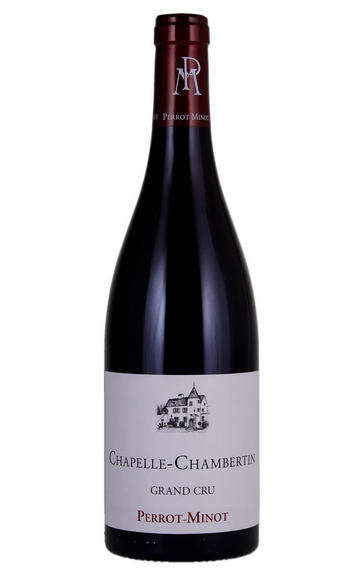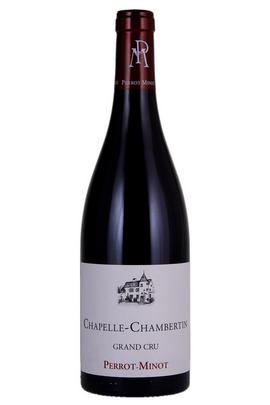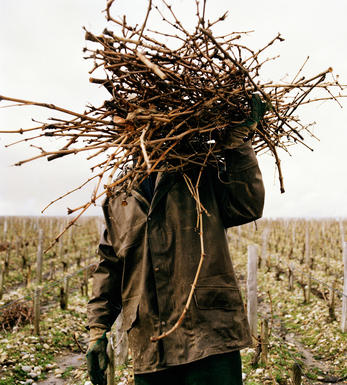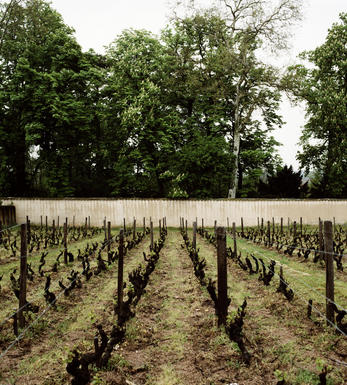
2010 Chapelle-Chambertin, Grand Cru, Vieilles Vignes, Domaine Perrot-Minot, Burgundy

Critics reviews
En Gémeaux
A cool, complex and refined nose juxtaposes notes of plum, dark berry fruit, earth and underbrush before sliding gracefully into intensely mineral-inflected medium weight flavors that possess ripe tannins and outstanding length. This is a wonderfully and almost painfully intense wine where the natural minerality of En Gémeaux is very much front and center in terms of defining its character. In short, this is a balanced and very impressive effort that should also require 12 to 15 years of cellar time to realize all of its remarkable potential.
Drink from 2022 onward
Allen Meadows, Burghound.com (January 2012)
The 2010 Chapelle-Chambertin is a racy beauty bursting with cassis, blackberries, white flowers and licorice. This is an exceptionally deep, dark Chapelle defined by its sheer power and huge, textured richness. Even with all of its size, the tannins remain silky and refined throughout. This parcel was picked during the first week of October.
It was great to meet up with Christophe Perrot-Minot, as I missed him last time around. Perrot-Minot is one of the most exciting domaines in Burgundy. Since 2006-2007 Christophe Perrot-Minot has begun to back away from the dark, concentrated wines he used to make, and the results are stunning. The fruit sees 5-7 days cold soak. Today Perrot-Minot does one punch down every two days, whereas previously he did three per day. In 2010 yields were down a whopping 45%. Over the last few years Perrot-Minot has expanded the range with a number of wines made from purchased fruit, including several that are sourced from Pierre Damoy. I tasted the Bourgogne, Gevrey and Chambolle from tank and the rest of the wines from barrel.
Drink 2025 - 2045
Antonio Galloni, Vinous.com (February 2012)
From 80-year-old vines and a very high percentage of tiny berries.
Full ruby. Pristine, primary aromas of cassis, crushed rock, licorice, bitter chocolate and violet. Dense, juicy and intense, with fruity, peppery acidity energizing the seamless but very unevolved middle palate. The extremely long, brisk finish leaves the taste buds vibrating. All of Perrot-Minot's 2010 grand crus will need at least a decade of bottle ageing.
Christophe Perrot-Minot noted that 2010 was his smallest vintage to date, with quantities down an average of 45% from 2009. He normally bottles about 240 barrels of wine, and in 2010 he will offer just 126. As a rule, yields were in the 25 hectoliters-per-hectare range. Perrot-Minot told me he did just one punchdown per day, compared to three a day back in 2000. Like many of his peers who attempted to make an impression with superconcentrated wines in the early stages of their careers, he has cut back dramatically on extraction and relied more on the quality of his fruit.
None of the 2010s had been racked at the time of my November visit and all of the wines were still in barrel, except for the Morey-Saint-Denis en la Rue de Vergy. Perrot-Minot was relying on the CO2 gas to protect the freshness and definition of the fruit, which he says works well when the tannins are very fine and the wine is essentially delicate. This looks like a splendid vintage for this estate, almost certainly for drinking after the 2009s, which are more approachable today.
Stephen Tanzer, Vinous.com (January 2012)
About this WINE

Domaine Perrot-Minot
Christophe Perrot-Minot took over from his father Henri in 1993. Part of the estate stems from the acquisition of Domaine Pernin-Rossin in 2000 while the remainder comes down from maternal grandfather Merme, which explains the similarity of holdings to Domaine Taupenot-Merme over the road. In addition to the domaine wines listed below, various other vineyards, most notably the various grands crus of Gevrey-Chambertin, are made from purchased grapes under the same label but without the word ‘domaine’.
The winemaking begins with exceptionally vigorous sorting of the grapes, first in the vineyard and then on two tables de tri. The grapes are destemmed before one week of cool pre-maceration, followed by fermentation with pumping over preferred to punching down, especially for the more fine-boned appellations such as Chambolle-Musigny. Maturation takes place over 12 to 14 months without racking, in barrels from the Tronçais and Allier forests supplied by tonnellerie Rémond, with 25 per cent new wood for village wines, 40 per cent for premiers crus and 50 per cent for the grands crus.
Two of the premiers crus, Chambolle-Musigny Combe d’Orveau and Nuits-St-Georges La Richemone come in regular vieilles vignes and ‘ultra’ versions from exceptionally ancient vines.
Jasper Morris MW, Burgundy Wine Director and author of the award-winning Inside Burgundy comprehensive handbook.

Gevrey-Chambertin
Gevrey-Chambertin is the largest wine-producing village in Burgundy’s Côte d'Or, with its vineyards spilling over into the next door commune of Brochon.
Located in the far north of the Côtes de Nuits above Morey-St Denis, classic Gevrey-Chambertin is typically deeper in colour, firmer in body and more tannic in structure than most red Burgundy. The best can develop into the richest, most complete and long-lived Pinot Noir in the world. This is largely thanks to the iron-rich clay soils, though much depends on whether the vineyard is located on either the steeper slopes (Evocelles, Clos St Jacques) or the flatter, richer soils (Clos Prieur, Combottes).
Whereas in the past there have been numerous underperformers in Gevrey-Chambertin exploiting the reputation of this famous village and its iconic Grands Crus, today there are many fine sources to choose from, and overall quality is higher than ever.
Gevrey-Chambertin’s greatest Grand Cru is named after the field of the monk Bertin (Champ de Bertin). In 1847, Gevrey appended the name of this illustrious vineyard, Chambertin, setting a trend for the other principle villages to follow. Le Chambertin may not be quite as sumptuous as Musigny or Richebourg, or as divinely elegant as La Tâche or Romanée-St Vivant, but it is matched only by the legendary Romanée-Conti for completeness and luscious intensity.
In all, Gevrey boasts an impressive nine Grands Crus, with the name of Chambertin retaining a regal omnipresence throughout its finest vineyard names. The other truly great Grand Cru is Chambertin-Clos de Bèze which has the right to sell its wines simply as ‘Chambertin’, and is the only wine allowed to put the Chambertin name before, rather than after, its own. Situated slightly further up the hill, the wines are fractionally less powerful yet full of sensual charm and finesse.
Quality-wise the next best are generally acknowledged to be Mazis-Chambertin and Latricières-Chambertin. The former is incredibly concentrated and very fine, but its structure is a little less firm than Le Chambertin. Latricières is less about power (although it can be explosively fruity) and more about an entrancing silkiness.
Situated slightly higher up the slope, Ruchottes-Chambertin is impressively rich, stylish and slightly angular. The tiny Griottes-Chambertin, which owes its name to the grill-pan shape of the vineyard rather than the wine’s griotte cherry aroma, is lower down the slope and boasts a velvety texture and rich fruit reminiscent of Chambertin itself. It is generally better than the lighter, although wonderfully fragrant Chapelle-Chambertin and Gevrey’s largest Grand Cru, the pure and seductive (if variable) Charmes-Chambertin.
Gevrey also has some outstanding Premier Crus on the south-east-facing slopes above the town. Les Cazetiers and especially Clos St Jacques produce some exceptional wines. Indeed Armand Rousseau, who pioneered domaine bottling here in the 1930s and is still one of the region’s very best producers, often sells his Clos St Jacques for more than several of his Grand Crus.
Drinking dates for these wines vary, but Grand Crus are generally best from at least 10 to 25 years, Premier Crus from eight to 20 years, and village wines from five to 12 years.
- 315 hectares of village Gevrey Chambertin
- 84 hectares of Premier Cru vineyards (20 in all). The foremost vineyards include Clos St Jacques, Lavaux St Jacques, Combottes, Corbeaux, Cherbaudes, Cazetiers.
- 55 hectares of Grand Cru vineyards: Chambertin, Chambertin Clos de Bèze, Latricières-Chambertin, Ruchottes-Chambertin, Mazis-Chambertin, Charmes-Chambertin, Mazoyères-Chambertin, Chapelle-Chambertin, Griottes-Chambertin..
- Recommended producers: Bachelet, Dugat, Esmonin, Mortet, Rossignol Trapet, Rousseau, Serafin, Bernstein
- Recommended restaurants : Chez Guy (good wine list), Rôtisserie du Chambertin (and Bistro)

Pinot Noir
Pinot Noir is probably the most frustrating, and at times infuriating, wine grape in the world. However when it is successful, it can produce some of the most sublime wines known to man. This thin-skinned grape which grows in small, tight bunches performs well on well-drained, deepish limestone based subsoils as are found on Burgundy's Côte d'Or.
Pinot Noir is more susceptible than other varieties to over cropping - concentration and varietal character disappear rapidly if yields are excessive and yields as little as 25hl/ha are the norm for some climats of the Côte d`Or.
Because of the thinness of the skins, Pinot Noir wines are lighter in colour, body and tannins. However the best wines have grip, complexity and an intensity of fruit seldom found in wine from other grapes. Young Pinot Noir can smell almost sweet, redolent with freshly crushed raspberries, cherries and redcurrants. When mature, the best wines develop a sensuous, silky mouth feel with the fruit flavours deepening and gamey "sous-bois" nuances emerging.
The best examples are still found in Burgundy, although Pinot Noir`s key role in Champagne should not be forgotten. It is grown throughout the world with notable success in the Carneros and Russian River Valley districts of California, and the Martinborough and Central Otago regions of New Zealand.


Buying options
Add to wishlist
Description
En Gémeaux
A cool, complex and refined nose juxtaposes notes of plum, dark berry fruit, earth and underbrush before sliding gracefully into intensely mineral-inflected medium weight flavors that possess ripe tannins and outstanding length. This is a wonderfully and almost painfully intense wine where the natural minerality of En Gémeaux is very much front and center in terms of defining its character. In short, this is a balanced and very impressive effort that should also require 12 to 15 years of cellar time to realize all of its remarkable potential.
Drink from 2022 onward
Allen Meadows, Burghound.com (January 2012)
wine at a glance
Delivery and quality guarantee